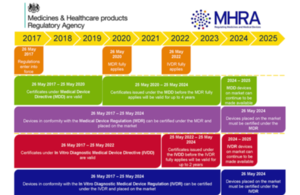Introductory Guide to new medical device regulations launched
The interactive guide will help new and experienced manufacturers navigate their obligations under new EU regulations on medical devices.

From sticking plasters to hip replacements, contact lenses to implanted pacemakers, medical devices are a part of everyday life. To make sure these medical devices are acceptably safe and perform as intended, they must comply with the relevant EU legislation.
The Medicines and Healthcare products Regulatory Agency (MHRA) has created an introductory guide to make sure manufacturers are aware of their obligations under the new EU regulations for medical devices (MDR) and in vitro diagnostic devices (IVDR).
Entering into force on 25 May 2017, the three and five year transition periods (also known as implementation) are now underway; the new regulations will apply across EU Member States from 26 May 2020 and 2022 respectively.
The Introductory Guide, designed as an interactive pdf, will help new manufacturers who may be looking at the regulations for the first time, and will also help experienced manufacturers navigate the changes in the new regulations.
The new regulations will include clearer obligations for those involved in manufacturing and supplying devices, a greater emphasis on traceability throughout the whole supply chain with the introduction of a unique device identification (UDI) system and new standards for clinical evidence. They also set out more rigorous vigilance reporting requirements, including new reporting timescales, as well as clearer requirements on what a manufacturer’s post-market surveillance system should comprise of. The new regulations are a balancing act of proportionate responsibility and an increasingly technological approach to healthcare.
Some products will become regulated under medical device legislation for the first time. Annex XVI of the MDR lists six categories of products similar to medical devices that do not have any medical benefit and are used for other purposes, such as dermal fillers, non-corrective contact lenses and brain stimulation devices. These products carry much of the same risks as medical devices and – under these new Regulations and detailed ‘Common specifications’ to be published by the European Commission – their manufacturers, importers and distributors will be regulated in the same way.
John Wilkinson, MHRA’s director of Medical Devices said:
We live in an increasingly digital world, and the way we provide our guidance is changing. We want to help manufacturers to comply with the new regulations as easily and as early as possible.
Our guidance is designed for all users – to help experienced manufacturers navigate the increased requirements for devices and diagnostics, as well as those manufacturers who will be new to the medical device regulations as a result of the broader scope of the new legislation.
Patient safety is our priority. It is expected that the implementation of these new regulations will clarify the role of competent authorities increase post-market surveillance to help protect both patients and industry alike.
Media enquiries
News centre
MHRA10 South Colonnade
London
E14 4PU
Email newscentre@mhra.gov.uk
Telephone (including out of hours): 020 3080 7651